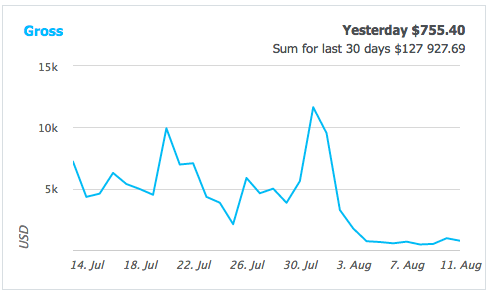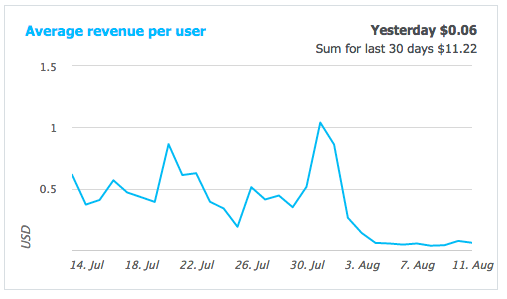As one report to answer the maximum questions?
recently, we in the Analytics service web and mobile applications devtodev has released a new Performance report. The report tested by our customers and gathered right after a flurry of accolades. We decided to elaborate on that, what is he so good.

My purpose in developing this report we set the maximum clarity and transparency. We wanted our client — the application developer (and a marketer, analyst, designer, application owner), by looking at this report to understand all about the current state of the project.
And that's what we did:
metrics. In the report, a total of 6 metrics. This:
the
Thus, the set of metrics includes a metric scale applications, analyzing which, we can understand how big this is, it grows or not (talking about metrics, Active Users, New Users, Gross), and qualitative metrics, which indicate internal changes in the project: did the project to keep the users, if users on average pay more (ARPU, 1-day retention, 7-days retention). This set of metrics is optimal and allows you to immediately look at the audience, and the money and quality retention.
evaluation Period of 30 days. We had to choose between 7, 14 and 30 days and stopped at 30 days because this is the best way to see and actual dynamics of the project, and the seasonal user behavior. For example, if in your project there is the rise of earnings every Friday and Saturday (which is quite typical for mobile games), in the period of 30 days you completely identify, and 7 or 14 days is not enough. That is, for each metric, you can see how she behaved during the past 30 days, to trace its dynamics, trend and seasonality.

Breakdown by country and device. We saw that our customers generally build reports in these sections and drew from this knowledge to use. Indeed, most want to know the structure of revenue or your audience by country and by platform. There is also a useful section on sources of traffic, but such a cut simply is not at all.

the Report opens by default. previous default, we have opened another report, which is updated every 5 minutes and shows cumulative values of the number of users and money in real time in comparison with yesterday. Against this report, we have nothing, he remained in devtodev, but we decided that the new Performance report answering more questions. Thus, we want to minimize the barriers between the application developer and the application itself, between data and decisions based on them.
So, what questions can be answered using the Performance report:
the
In particular, with a Performance report you can address the following hypothetical (and quite probable) cases:
the 1. the project falls income. We look at the audience and average revenue user (ARPU).



Based on this, we know where to run, to a marketer or designer, and what to do, buy new traffic or to look for reasons within the product itself, to assess its changes over the past 30 days (in the example this is the case!).
the 2. the project fell audience. Two hypotheses: either began to come less beginners project either worse keep existing users (look at retention). If less beginners — go to a marketer and ask what happened (maybe just the money on traffic stops), if the retention — look what we did in the project in recent days. Moreover, comparing the behavior of 1-day retention and 7-days retention, we can assess whether the fall with the change in the first user session, or with a main loop using the app (core loop).
the 3. What we're all about drops. For example, we have noticed a quality increase of 1-day retention (say, last 30 days, we remade the first session, and users are better to stay from the beginning). Here we can see how the impact is a qualitative change in audience growth and income.

Please note, this is all done in one place, in one report, without a single click on it. He opens by default: you start devtodev and once you see the basic information about the project.
Of course, with the help of only one such report it is impossible to obtain absolute knowledge about the project. If you want more detailed information — please, we have dozens of other useful reports. But we continue to insist: the role of the first report, which the user sees on the project Performance to cope fine.
Article based on information from habrahabr.ru

My purpose in developing this report we set the maximum clarity and transparency. We wanted our client — the application developer (and a marketer, analyst, designer, application owner), by looking at this report to understand all about the current state of the project.
And that's what we did:
metrics. In the report, a total of 6 metrics. This:
the
-
the
- Active Users (DAU) is the number of unique users, who visited the project during the day; the
- New Users — number of unique users who on this day first called for the application; the
- Gross — the total amount of money this day paid by users; the
- ARPU (Average Revenue Per User) — average revenue per active user for that day is calculated as Gross / Active Users; the
- 1-day retention — the percentage of users who returned to the app later, 1 day after the first visit. As a rule, this metric is used when speaking about the short-term user retention: whether they liked the look of the app, whether they understand it can be useful to them; the
- 7-days retention — the percentage of users who returned to the application 7 days after first visit. Users remaining in app for 7 days more details it was sorted out and less likely to leave in the coming days.
Thus, the set of metrics includes a metric scale applications, analyzing which, we can understand how big this is, it grows or not (talking about metrics, Active Users, New Users, Gross), and qualitative metrics, which indicate internal changes in the project: did the project to keep the users, if users on average pay more (ARPU, 1-day retention, 7-days retention). This set of metrics is optimal and allows you to immediately look at the audience, and the money and quality retention.
evaluation Period of 30 days. We had to choose between 7, 14 and 30 days and stopped at 30 days because this is the best way to see and actual dynamics of the project, and the seasonal user behavior. For example, if in your project there is the rise of earnings every Friday and Saturday (which is quite typical for mobile games), in the period of 30 days you completely identify, and 7 or 14 days is not enough. That is, for each metric, you can see how she behaved during the past 30 days, to trace its dynamics, trend and seasonality.
Breakdown by country and device. We saw that our customers generally build reports in these sections and drew from this knowledge to use. Indeed, most want to know the structure of revenue or your audience by country and by platform. There is also a useful section on sources of traffic, but such a cut simply is not at all.
the Report opens by default. previous default, we have opened another report, which is updated every 5 minutes and shows cumulative values of the number of users and money in real time in comparison with yesterday. Against this report, we have nothing, he remained in devtodev, but we decided that the new Performance report answering more questions. Thus, we want to minimize the barriers between the application developer and the application itself, between data and decisions based on them.
So, what questions can be answered using the Performance report:
the
- how many users comes in a day? the
- how much money do they pay? the
- as the project keeps users? the
- as all these indicators have changed over the past 30 days? the
- was there a qualitative change in the project as they reflected on the scale?
what is the size of the audience of the project? the
what are the most popular for the audience and the money of the country and the platform?
In particular, with a Performance report you can address the following hypothetical (and quite probable) cases:
the 1. the project falls income. We look at the audience and average revenue user (ARPU).
Based on this, we know where to run, to a marketer or designer, and what to do, buy new traffic or to look for reasons within the product itself, to assess its changes over the past 30 days (in the example this is the case!).
the 2. the project fell audience. Two hypotheses: either began to come less beginners project either worse keep existing users (look at retention). If less beginners — go to a marketer and ask what happened (maybe just the money on traffic stops), if the retention — look what we did in the project in recent days. Moreover, comparing the behavior of 1-day retention and 7-days retention, we can assess whether the fall with the change in the first user session, or with a main loop using the app (core loop).
the 3. What we're all about drops. For example, we have noticed a quality increase of 1-day retention (say, last 30 days, we remade the first session, and users are better to stay from the beginning). Here we can see how the impact is a qualitative change in audience growth and income.
Please note, this is all done in one place, in one report, without a single click on it. He opens by default: you start devtodev and once you see the basic information about the project.
Of course, with the help of only one such report it is impossible to obtain absolute knowledge about the project. If you want more detailed information — please, we have dozens of other useful reports. But we continue to insist: the role of the first report, which the user sees on the project Performance to cope fine.